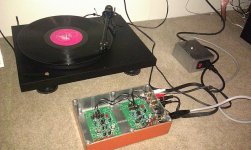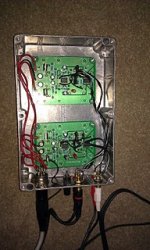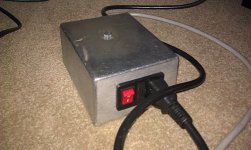Ordered the VSPS kit, and it's on the way. Can't wait!
However, I'm broke at the moment, and can't afford a toroid and all the parts for a real power supply. In the meantime, is it ok if I hook the preamp up with a 12v wall wort? Blasphemy, I know... but I have no other option for a month or two.
However, I'm broke at the moment, and can't afford a toroid and all the parts for a real power supply. In the meantime, is it ok if I hook the preamp up with a 12v wall wort? Blasphemy, I know... but I have no other option for a month or two.
Will not work. You need +17 V and -17 V DC supplies or at the very least a small 12 V AC transformer and two diodes. Preferably two 12 V AC transformer windings (you can use two transformers, one secondary each, or a single transformer with two 12 V secondaries), and eight diodes (two bridge rectifiers).
Surely you can scrounge a couple of trannies with 12 VAC outputs?
Surely you can scrounge a couple of trannies with 12 VAC outputs?
Why sureNo photo to show the VSPS circuit itself?
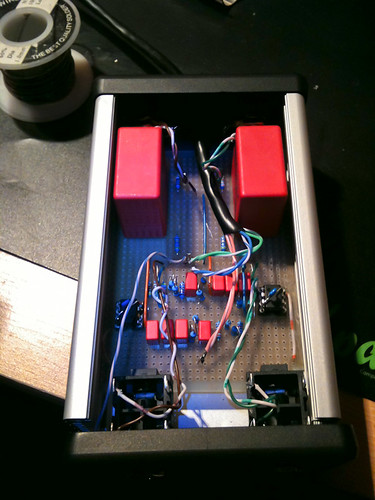
PCB with straight traces at the back - horizontally to the picture. Grounds come together in one trace (except line outputs which are at the back). Kind of a hybrid between VSPS / VSPS 300. I'm using NE5532 at the moment which I had lying around, but I can quickly rewire for single op-amps.
I've put the Talema transformer in too and earthed the casing as well. Whatever little 100Hz harmonics was left (only measurable..), is now totally gone.
Rebuilding Power supply for Phonoclone
Hi there!
I've just rebuilt the powersupply for a phonoclone I built 3 or so years ago, (I never got around to putting the previous powersupply into a case and it broke)
Anyway, starting from scratch, I bought a 12v toroidal transformer
(part 12V-0-12V 20VA Toroidal Transformer - Low Profile - Jaycar Electronics)
20VA - not as much guts as my previous transformer but it will do.
With the original power supply, I only used one rectifier, but I notice on the current phonoclone website, it suggests using two rectifiers. I am now a little confused, because my original power supply worked just fine. The way I have it set up is like this:
Two 12v secondaries: I connect up the output of one of the 12v secondaries to the other, to create a "ground" which goes to the phonoclones. The remaining two secondary outputs go to the AC ins on the rectifier, the plus and minus outputs of the rectifier go to supply the positive and negative rail 12v DC supply to the phonoclone.
I hope this makes sense! Is this ok to do? (it worked fine before)
Graeme.
Hi there!
I've just rebuilt the powersupply for a phonoclone I built 3 or so years ago, (I never got around to putting the previous powersupply into a case and it broke)
Anyway, starting from scratch, I bought a 12v toroidal transformer
(part 12V-0-12V 20VA Toroidal Transformer - Low Profile - Jaycar Electronics)
20VA - not as much guts as my previous transformer but it will do.
With the original power supply, I only used one rectifier, but I notice on the current phonoclone website, it suggests using two rectifiers. I am now a little confused, because my original power supply worked just fine. The way I have it set up is like this:
Two 12v secondaries: I connect up the output of one of the 12v secondaries to the other, to create a "ground" which goes to the phonoclones. The remaining two secondary outputs go to the AC ins on the rectifier, the plus and minus outputs of the rectifier go to supply the positive and negative rail 12v DC supply to the phonoclone.
I hope this makes sense! Is this ok to do? (it worked fine before)
Graeme.
Two 12v secondaries: I connect up the output of one of the 12v secondaries to the other, to create a "ground" which goes to the phonoclones. The remaining two secondary outputs go to the AC ins on the rectifier, the plus and minus outputs of the rectifier go to supply the positive and negative rail 12v DC supply to the phonoclone.
I hope this makes sense! Is this ok to do? (it worked fine before)
That's the way I do it on my toroidial. I've got two 15V secondaries. One output to the other. The outer two connect to your rectifier - the connection between your two secondary's is your "ground".
You can use one or two bridge rectifiers. I recommend using two, because there is less chance of messing up, and because I think this configuration sounds better.
The plus and minus (technically incorrect term, actually one phase or the other) are not obvious which is which, so people connect minus and minus, say, the power supply does work. With two rectifiers as long as you can read the labels on the bridge, and identity the windings, you are good to go.
The plus and minus (technically incorrect term, actually one phase or the other) are not obvious which is which, so people connect minus and minus, say, the power supply does work. With two rectifiers as long as you can read the labels on the bridge, and identity the windings, you are good to go.
Thanks for your reply!
I think for this supply I will stick with the single rectifier, and I might build another one later with larger toroidal and two rectifiers as an upgrade. Unfortunately as I said in my last post the other power supply broke and that had a much larger toroidal inside ( (I snapped one of the leads off the transformer).
I think for this supply I will stick with the single rectifier, and I might build another one later with larger toroidal and two rectifiers as an upgrade. Unfortunately as I said in my last post the other power supply broke and that had a much larger toroidal inside ( (I snapped one of the leads off the transformer).
Well, after a year or so rest, my phonoclone fired up pretty well this afternoon!
I've attached some pics of my turntable, phonoclone preamp and power supply.
Can I ask you a dumb question - why should the preamp powersupply have a large Va?
I've attached some pics of my turntable, phonoclone preamp and power supply.
Can I ask you a dumb question - why should the preamp powersupply have a large Va?
Attachments
Can I ask you a dumb question - why should the preamp powersupply have a large Va?
I don't think that changes anything, having large VA. You just need an adequate power supply, with decent filtering.
Thanks for the reply. I really love the phonoclone. I want to build a decent tube amp as well... I have built a pair of E.J. Jordan full frequency TL speakers. At the moment, I have a NAD 3121 which is pretty good for its age.
As an experiment I just plugged my phonoclone into the Blueray player surround system's AUX input. It sounds great.
As an experiment I just plugged my phonoclone into the Blueray player surround system's AUX input. It sounds great.
Can I ask you a dumb question - why should the preamp powersupply have a large Va?
Simple answer is larger transformers tend to sound more "solid" and "powerful".
Anything over 25 VA should be sufficient, but 160VA-225VA can be considered an optional upgrade path. Depending on the supplier, there isn't always a lot of different in price vs. VA, so one larger transformer might be more cost effective than two smaller ones.
If you want a PCB-mountable version,Bürklin in Germany stocks them. Exceptionally fast shipping (2-day max in Europe). http://www.buerklin.com
I measured the Noise Level on my VSPS stage. Pretty good, as there's nothing too exotic component-wise.
This was measured using an E-MU 0404 USB (s/n ratio 113dB - sampled at 24-bit / 92kHz). After setting the sensitivity of the Line-In's to the maximum (without clipping) for a line signal, I came up with the following graph:
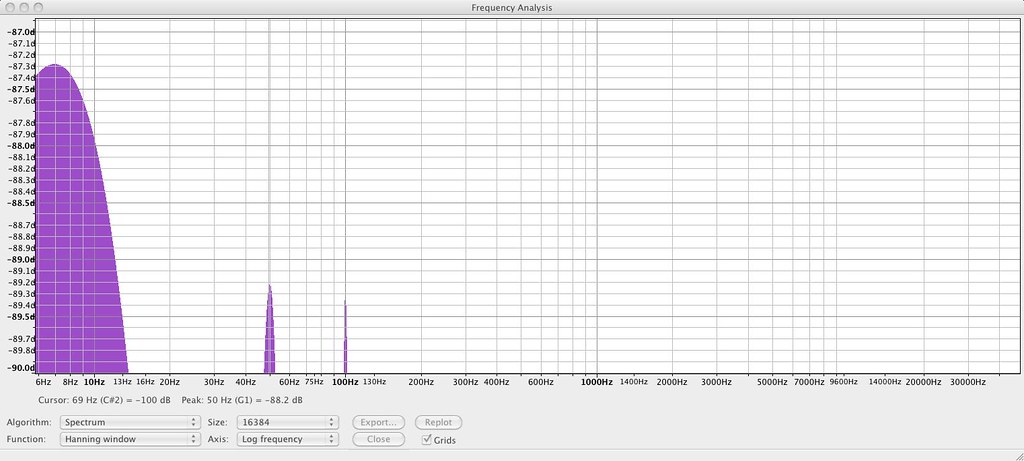
First of all - the resonant frequency of my cartridge & tonearm seems to be 7Hz, but overall, it's great. Only a little 50Hz and 100Hz noise left, coming from the PSU. But it's at -89.2dB, so no biggie
This was measured using an E-MU 0404 USB (s/n ratio 113dB - sampled at 24-bit / 92kHz). After setting the sensitivity of the Line-In's to the maximum (without clipping) for a line signal, I came up with the following graph:

First of all - the resonant frequency of my cartridge & tonearm seems to be 7Hz, but overall, it's great. Only a little 50Hz and 100Hz noise left, coming from the PSU. But it's at -89.2dB, so no biggie
Since the y-axis is not referenced, I can't say for sure, but whatever hum you are picking up here is most likely through the cartridge. The "true" output noise of the VSPS300 can be estimated by replacing unplugging the phono cable and putting 1 kohm across the input instead.
To calibrate your y-axis, adjust until an input signal of 1 kHz sine wave / 1 V rms returns a peak of 0 dB in the FFT.
To calibrate your y-axis, adjust until an input signal of 1 kHz sine wave / 1 V rms returns a peak of 0 dB in the FFT.
Allright, thanks for the info for taking measurements! I disconnected the turntable, put 1Kohm 1 percent tolerance resistors across the inputs, and I've adjusted the input with a 1Khz sinewave to 0dB.
This is what I get:

Noise Level - 1kOhm - Calibrated @ 0dB @ 1kHz
50Hz peaks at -91.6dB; I guess it's OK, but I'll be looking at some additional filtering of the power supply. Using 7815/7915 now in separate housing. It's not bad at all, but there's always room for improvement
This is what I get:

Noise Level - 1kOhm - Calibrated @ 0dB @ 1kHz
50Hz peaks at -91.6dB; I guess it's OK, but I'll be looking at some additional filtering of the power supply. Using 7815/7915 now in separate housing. It's not bad at all, but there's always room for improvement
- Home
- Source & Line
- Analogue Source
- The Phonoclone and VSPS PCB Help Desk
 Just ordered me a 10VA 230V > 2x15V
Just ordered me a 10VA 230V > 2x15V